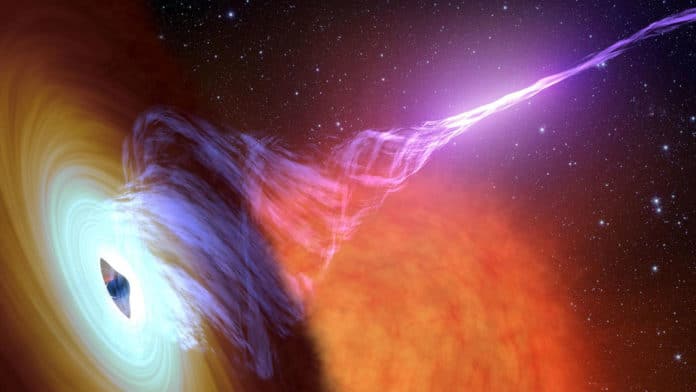Since years, astrophysicists suspect that high-energy radiation makes neutron stars and black holes shine bright. According to them, the radiation is generated by electrons that move at nearly the speed of light. But the process that accelerates these particles has remained a mystery.
Now, scientists from Columbia University have shed new light on this and offered a new explanation for the physics underlying the acceleration of these energetic particles.
Scientists used massive super-computer simulations to quantify the mechanisms that accelerate these particles. They reasoned that their stimulation is the result of the interaction between chaotic motion and reconnection of super-strong magnetic fields.
Astrophysicist Luca Comisso, a postdoctoral research scientist at Columbia and first author on the study, said, “Turbulence and magnetic reconnection—a process in which magnetic field lines tear and rapidly reconnect—conspire together to accelerate particles, boosting them to velocities that approach the speed of light. A hot gas of charged particles permeates the region that hosts black holes and neutron stars, and the magnetic field lines dragged by the chaotic motions of the gas, drive vigorous magnetic reconnection.”
“It is thanks to the electric field induced by reconnection and turbulence that particles are accelerated to the most extreme energies, much higher than in the most powerful accelerators on Earth, like the Large Hadron Collider at CERN.”
Examining turbulent gas cannot foresee chaotic motion accurately, as dealing with the mathematics of turbulence is quite tricky. Scientists designed extensive supercomputer simulations to tackle this challenge. They created the simulations to solve the equations that describe the turbulence in a gas of charged particles.
Lorenzo Sironi, an assistant professor of astronomy at Columbia and the study’s principal investigator, said, “We used the most precise technique—the particle-in-cell method—for calculating the trajectories of hundreds of billions of charged particles that self-consistently dictate the electromagnetic fields. And it is this electromagnetic field that tells them how to move.”
“The crucial point of the study was to identify role magnetic reconnection plays within the turbulent environment. The simulations showed that reconnection is the key mechanism that selects the particles that will be subsequently accelerated by the turbulent magnetic fields. They s also revealed that particles gained most of their energy by bouncing randomly at an extremely high speed. When the magnetic field is strong, this acceleration mechanism is very rapid. But the strong fields also force the particles to travel in a curved path, and by doing so, they emit electromagnetic radiation.”
“This is indeed the radiation emitted around black holes and neutron stars that make them shine, a phenomenon we can observe on Earth.”
Scientists noted, “The ultimate goal is to get to know what is going on in the extreme environment surrounding black holes and neutron stars, which could shed additional light on fundamental physics and improve our understanding of how our universe works.”
Scientists further want to connect their work even more firmly by comparing their predictions with the electromagnetic spectrum emitted from the Crab Nebula.
Comisso said, “We figured out an important connection between turbulence and magnetic reconnection for accelerating particles, but there is still so much work to be done. Advances in this field of research are rarely the contribution of a handful of scientists, but they are the result of a great collaborative effort.”
Journal Reference
- Luca Comisso, The Interplay of Magnetically Dominated Turbulence and Magnetic Reconnection in Producing Nonthermal Particles. DOI: 10.3847/1538-4357/ab4c33
